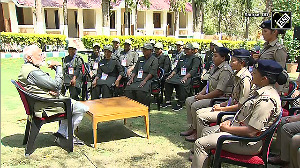The Income Tax Act empowers the CBDT to capture information in respect of payments to non-residents, whether taxable or not
Illustration: Dominic Xavier/Rediff.com

The reporting and certification requirement in case of payments to non-residents has come under the Income Tax department’s scanner.
The Central Board of Direct Taxes (CBDT) has directed tax sleuths to verify the “high-risk remittance” data and initiate action in the necessary cases.
The CBDT has formulated a set of revised risk parameters for selecting high-risk remittance data from forms 15CA/CB, required to be furnished by an individual if they make any payment to a non-resident, which are taxable and the payment amount during the year exceeds Rs 500,000.
The apex body wants relevant information to be made available to the assessing officer by August 15.
This follows a 66-page action plan drawn up by the CBDT, where an aggressive strategy was outlined to nab tax dodgers.
The CBDT had circulated a strategy paper for tax officials and laid special emphasis on a number of critical areas such as litigation management, widening the tax base, verification of non-permanent account number data, implementation of equalisation levy and the processing of the foreign account tax compliance act (FATCA) data.
"The major part of collections in international taxation charges come from tax withheld from remittances made to non-residents."
The strategy to augment revenue through this requires a combination of proactive measures related to enforcement, capacity building (external and internal) and leveraging of available information.
Experience gained from the verification of remittance data carried out in the past years has highlighted the need to apply more focused and effective risk parameters in selecting high-risk data for verification.
Equally important is the need to process more current information and gradually progress to a state where high-risk information is identified, processed and acted upon on a real-time basis, the CBDT action plan stated.
The Income Tax Act empowers the CBDT to capture information in respect of payments to non-residents, whether taxable or not.
To further curb the misuse of certain tax provisions around non-residents, the apex body wants proper checking of their liaison offices in India.
“Form 49C is a strong tool for procuring information about the activities of Liaison Offices, so as to verify the claim of the non-resident that his/her activities in India are not taxable,” the CBDT noted, adding that there is a need for standard operating procedures for effective utilisation of this information.
Further, the CBDT asked sleuths to focus on proper implementation of equalisation levy, a new tax, which is withheld at the time of payment to a non-resident service provider.
At present, access to the form concerned is available only with the assessing officer of the payer/remitter who is normally an Indian resident.
However, the levy actually relates to income of the non-resident recipient and needs to be correlated with the gross receipts of that non-resident, the CBDT said.
Besides, the apex body of direct taxes wants sleuths to initiate action on defaults in immovable property transactions based on annual information returns.
For this, the CBDT has suggested matching data on sale of immovable properties over threshold limit with transactions on which tax deducted at source (TDS) has been deducted and accordingly generate list of defaulters.
It has been observed in several cases that the buyer of the property deducts only at the rate of 1 per cent of TDS on purchase of immovable property from NRIs, which actually requires TDS at 20 per cent.
These are high-risk cases, which need to be taken up on a priority basis.
Action may be taken in such cases to augment revenues, CBDT said. Other than these, the CBDT wants the tax officer to use more effective tools for detection of non-compliance in TDS and identify defaults.
The apex body wants each officer to do at least 20 survey operations during the year.
The survey cases may be identified based on the names in the prosecution list, companies showing negative trend in payment, habitual late filers and cases of sick units with negative operating margins.
The CBDT believes that promotion of voluntary compliance through non-intrusive tax administration and strengthening the mechanism for tax deterrence are the cornerstones of the present tax policy and administration.
Achievement of these objectives is possible only by way of collection, collation and verification of vital information about financial transactions, by the income-tax department.
To make this effective, CBDT wants tax officials to access to credible and processed information through “Insight Portal” , a reporting portal where reporting entities furnishes the statement of financial transactions (SFTs).
CBDT urges those concerned to ensure complete and correct filing of the SFTs.
Further, the Special Pilot Projects to identify areas, which can be of vital importance for deepening and widening of the tax base, verification of non-PAN data and the processing of the FATCA, continue to be extremely important functions of the department, said CBDT.
CBDT also asked to cover those sectors, which have not been covered adequately and preferably cases of Statutory Regulatory Orders, co-operative banks and authorised forex dealers for capturing more PAN cards.
According to CBDT, various initiatives were taken to increase the tax base and the number of new return filers, which have shown appreciable results.











 © 2025
© 2025